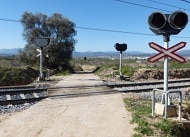The notion of level crossing is used to name the place where a railway track meets another road that is at the same height . The level crossing, therefore, assumes that a railway crosses a street , a highway , etc.
This term is made up of two main words that have their etymological origin in Latin. Step, first of all, derives from the word "passus", which means "to pass" or "to move one foot in front of the other." Level, secondly, comes from "libella", which can be translated as "small scale".
 The existence of a level crossing always implies a risk . Trains , due to their characteristics, cannot stop in a few meters, but rather need to execute the action at a considerable distance from the place where they must stop. That is why railway formations have priority of passage .
The existence of a level crossing always implies a risk . Trains , due to their characteristics, cannot stop in a few meters, but rather need to execute the action at a considerable distance from the place where they must stop. That is why railway formations have priority of passage .
To avoid collisions, level crossings must be clearly marked . Furthermore, it is common for resources such as traffic lights and barriers to be used to manage traffic at the crossing and give notice of the imminent arrival of a train at the point in question.
Specifically, we can establish that the automatic protection systems for a level crossing include both light and acoustic signaling and the so-called semi-barriers. These can be of two types: SBE (Semi Interlocked Barriers) and SBA (Semi Automatic Barriers).
In the same way, on the road that will lead to a level crossing, it is essential to warn of it using vertical traffic signs. Fundamentally there can be three types:
-A triangle with a red border and a white interior that has a drawing of a barrier inside. What this sign indicates is danger because nearby there is a protected level crossing that has barriers and the relevant acoustic and light signaling.
-A triangle with a red border and a white interior that has the drawing of a train on it. This sign indicates that you are close to a level crossing that does not have barriers. That is, it is unprotected.
Likewise, there is another signal that is directed to the train driver and tells him that he is approaching a protected and functional level crossing. This sign is formed by a black vertical rectangle inside which there are two types of white brackets facing each other.
Take the case of a level crossing at the intersection of a road with a busy avenue in a city. The train, due to its priority of passage and the technical impossibility of a quick stop, always crosses without braking. It is motorists and pedestrians who must interrupt their journey when, upon arriving at the level crossing, they encounter the low barrier and an audible alarm that warns that the railway formation is about to arrive. Once the train leaves the level crossing behind, the barrier is raised and circulation on the avenue resumes.
With the intention of not impeding the flow of traffic and minimizing accidents, there is a tendency to abandon level crossings and replace them with overpasses : in this case, the roads that intersect are at different heights. thanks to bridges , tunnels and other structures.
